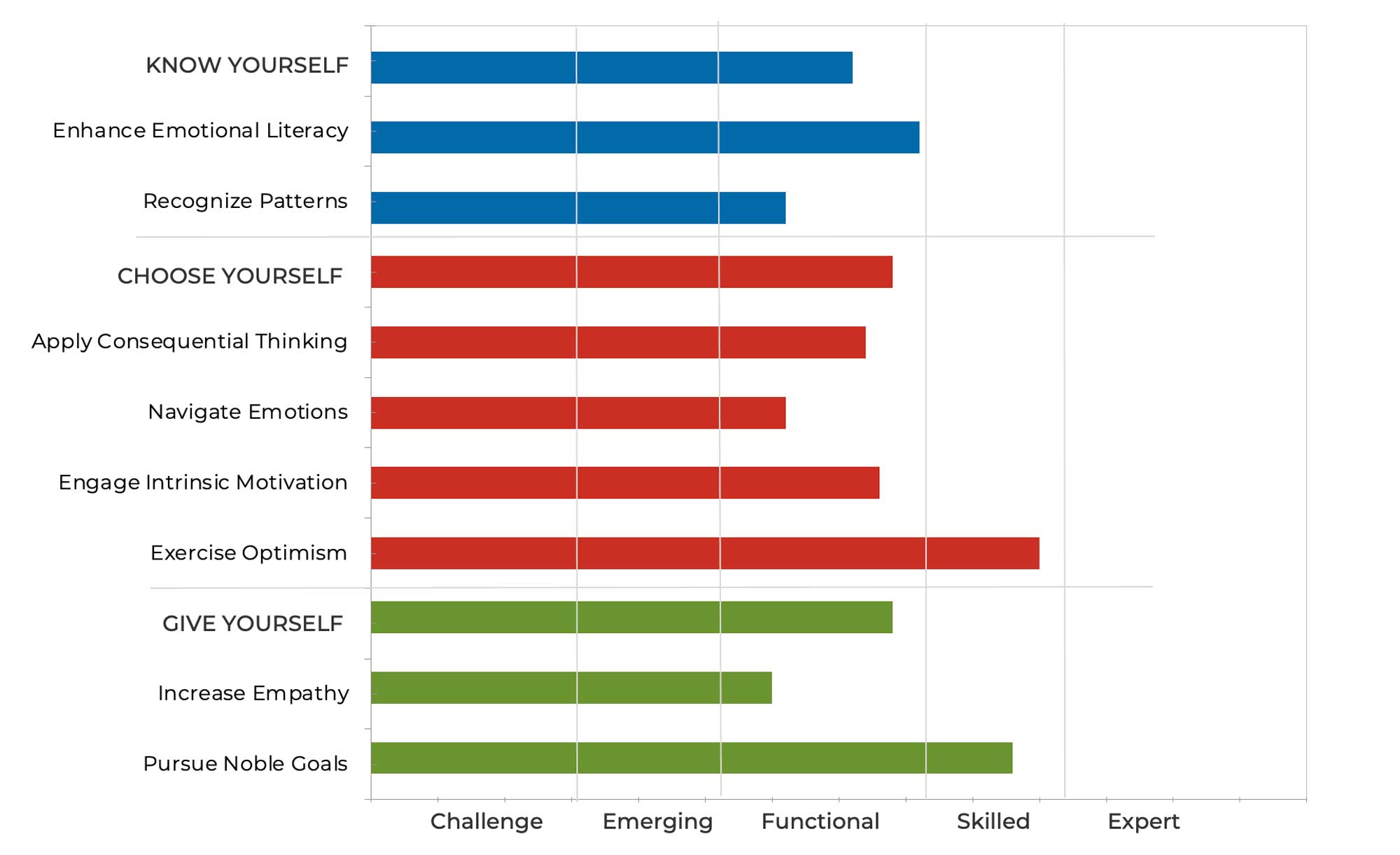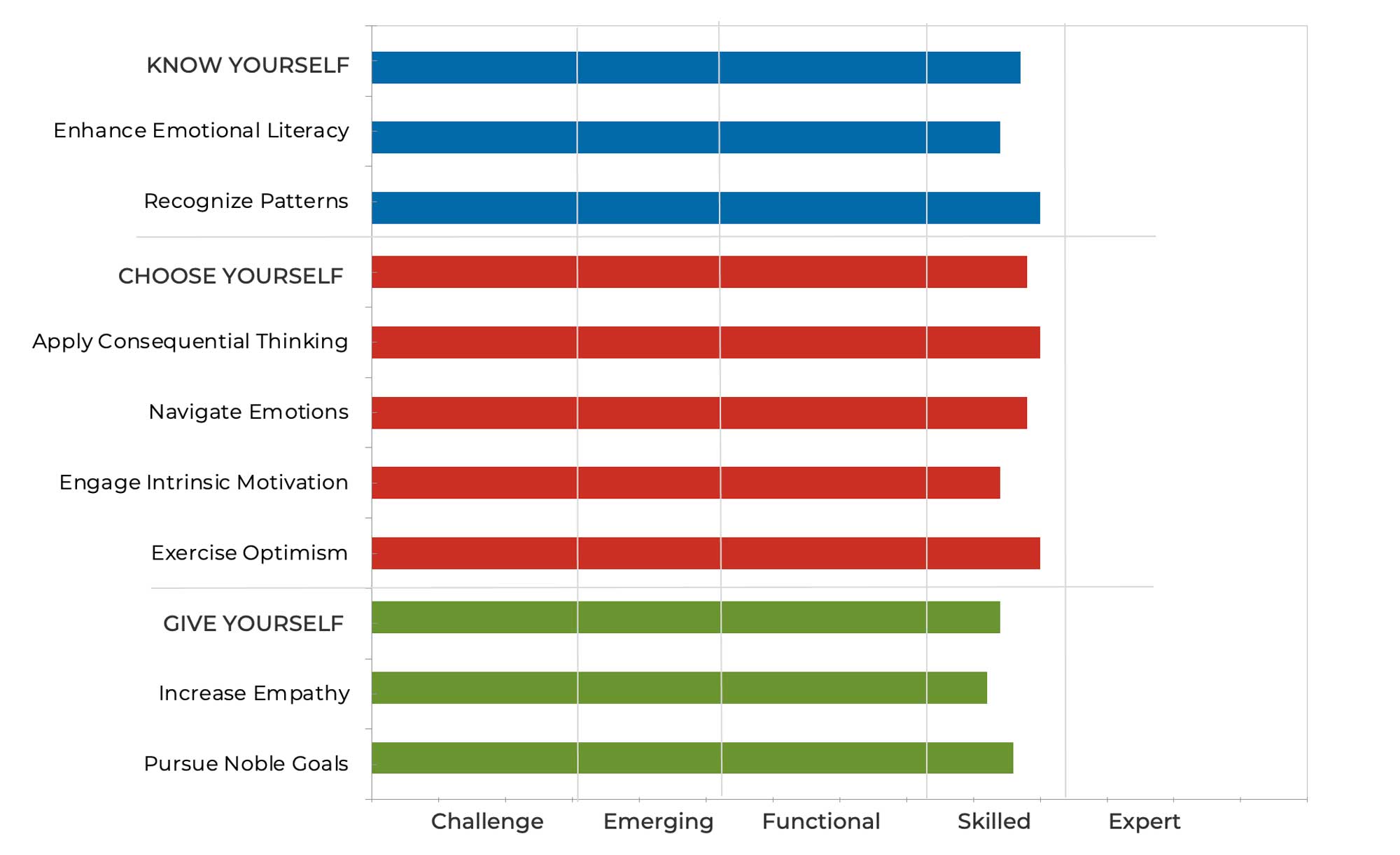Is your negativity bias pushing you to get your coaching clients to focus on ‘what’s wrong’?
As coaches, we meet our clients ‘where they are’ and support them to walk toward their goals. Yet when clients say, ‘everything is fine,’ it can be tough to know how to engage. Our new video explains how to take a positive-psychology approach to working with strengths. We can do the same when using assessments.
If you use any normed assessments in your coaching, you’ve probably experienced a client with unusually high scores. I’ll walk you through an example of this using the SEI, one of the psychometric assessments I’ve co-authored. You can apply this same strength-based logic to any effective measurement tool.
The Six Seconds Emotional Intelligence Assessment (SEI) offers valuable leverage to take coaching further, faster because it’s not just a diagnostic tool – it’s a roadmap for growth.
Sometimes it’s super-easy to see the challenges and opportunities, for example, in this graph:
Potential strengths and opportunities jump out (in the graph above); a likely hypothesis is this client is showing up with…
- strong sense of possibility (high Exercise Optimism)
- vision of the future (high Pursue Noble Goals)
- yet challenged to see their own behavior (lower Recognize Patterns)
- struggles with harnessing emotions (lower Navigate Emotions) and
- some difficulty connecting (lower Increase Empathy).
A coach would explore these possibilities with the client, and most likely, find fertile ground for coaching quickly. Particularly since the SEI is linked to real-life outcomes (see the EQ & Success White Paper explaining how EQ predicts effectiveness, wellbeing, quality of life and relationships) it would be easy for a coach who’s a Certified EQ Assessor or Certified EQ Coach to help a client create awareness and then quickly build a powerful plan of action.
Watch Out for Your Negativity Bias
But what happens in a profile like this one where the scores are “all good”? Like in this graph:
Particularly since a score like this is uncommon, coaches who see this might wonder if the client has been “overly rosy” (ie, self-deceiving) when answering the questionnaire. As I discuss in this video, it could be that negativity bias is getting in the way.
This may be a time for Six Seconds’ principle of Wisdom Lives Within. What if we lean into trusting the client and meeting them where they are? In an identify-affirming, asset-focused approach, this “too good to be true” graph is something to celebrate!
We could then ask questions such as:
- The graph shows all your competencies are quite strong – how does that match what you know about yourself?
If they affirm these are strengths, continue…
- What are some feelings that come up for you as you see this graph affirming your strengths?
- What’s helped you grow your strengths in emotional intelligence?
- How are you using your EQ strengths now?
- What about that gives you energy or fuels you?
Now that we’ve affirmed and celebrated the strengths, it might be easier for the client to identify an area where they’re not using their strengths in an optimal way…
- Even people with a lot of strength might find times where they don’t use the strength effectively – for example someone might be good at empathy, but forget to use it with certain people. Do you relate to that?
If yes…
- What’s a situation where you’d like to use your strengths differently?
If they identify an area, you can build on their past experience… - Earlier you mentioned that you grew your strengths by ____ [fill in key words from question 3] – I wonder if one of those strategies might help you with this?
Wrap up by returning to the strengths – this is the BROADEN part of Build & Broaden: - What’s one of your strengths you are particularly excited about leveraging right now? What’s one way you might do that?
- What are some feelings that might help you in applying this strength?
How does this land for you as a coach? Please share a comment below!
And, if you have questions you’d like me to explore in a future 🌱 EQ Coaching newsletter and/or video, please post in the comments, or feel free to reach out to me via our contact form.
… and don’t forget to Click here to subscribe to the EQ Coach Newsletter.
🌱
For more on EQ and Coaching 🌱, I recommend:
- Coaching Through the Emotional Recession: Three Practical Tips for Trauma-Informed Coaching - May 1, 2024
- Knowing Isn’t Coaching: Three Emotional Intelligence Tools for Professional Coaches - April 3, 2024
- Coaching Down the Escalator: 3 Emotional Intelligence Tips forCoaches to Reduce Volatility & De-escalate Conflict in a Polarized World - March 6, 2024



Once in a while I do get some of these very score SEI profile. Sometimes, the client/participant would say – I think I am very good right? While others, do humbly ask, what do these scores mean? Yes, removing personal bias as a coach is one of the key to explore the wisdom lies within – and the coaching questions you shared are absolutely powerful in this situation – I have used some of them. – esp how they have used their strengths and what kind of results they received – and we continue coaching from there. At some stage, the client will still have a need to do something differently or even bring them to the next level. The more I use SEI, the more I enjoy my coaching experience with the clients and participants of my workshop. No two individuals are the same.